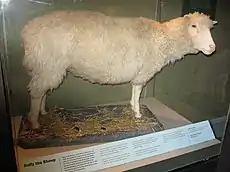Biofact (philosophie)
Le terme biofact a été introduit dans le débat philosophique par Nicole C. Karafyllis pour la première fois en 2001[1] - [2] pour traduire le fait que les êtres vivants peuvent être, en grande partie, artificiels, grâce à des méthodes telles que le clonage et le génie génétique.

Le corps naturalisé de la brebis clonée Dolly.
Le terme « biofact » est formé à partir du mot grec βιος (bios) signifiant « vie » et du participe passé du verbe latin facere signifiant « faire ».
Les artéfacts sont artificiels : ce sont des objets inertes créés par l'homme et qui n'existent donc pas à l'état naturel. Les biofacts sont également créés par l'homme mais sont animés et affichent un caractère hybride.
Références
- Biologisch, Natürlich, Nachhaltig. Philosophische Aspekte des Naturzugangs im 21. Jahrhundert, Tübingen: Francke 2001, chapitre 6.
- Biofakte - Versuch über den Menschen zwischen Artefakt und Lebewesen. Paderborn: Mentis 2003.
Bibliographie
- (en) Suzanne Anker, "Technogenesis", in: B. Andrew Lustig, Baruch A. Brody, Gerald P. McKenny (Eds.): Altering nature: concepts of nature and the natural in biotechnology debates, Springer 2008, p. 275-322.
- (de) Dieter Birnbacher: Natürlichkeit. Berlin/Bew York: De Gruyter 2006.
- (de) Christoph Hubig: Die Kunst des Möglichen I. Bielefeld: transcript 2006.
- (de) Nicole C. Karafyllis (ed.): Biofakte - Versuch über den Menschen zwischen Artefakt und Lebewesen. Paderborn, Mentis 2003.
- (de) Nicole C. Karafyllis: Biofakte - Grundlagen, Probleme, Perspektiven. Discussion Unit in the journal Deliberation Knowledge Ethics / Erwaegen Wissen Ethik, Vol. 17, Nr. 4 (2006).
- (en) Nicole C. Karafyllis: Growth of Biofacts: the real thing or metaphor?. In: R. Heil, A. Kaminski, M. Stippack, A. Unger and M. Ziegler (Ed.): Tensions and Convergences. Technological and Aesthetic (Trans)Formations of Society. Bielefeld 2007. 141-152.
- (en) Nicole C. Karafyllis: Endogenous Design of Biofacts. Tissues and Networks in Bio Art and Life Science. In: sk-interfaces. Exploding borders - creating membranes in art, technology and society. Ed. by Jens Hauser. Liverpool: University of Liverpool Press 2008, 42-58.
- (en) Torsten Meyer et Uta Hassler: "Construction History and the History of Science ", Proceedings of the Third International Concress of Concstruction History, Cottbus May 2009.
- (en) Orlan: A Hybrid Body of Artworks, ed. by S. Shepherd and Orlan, Taylor&Francis 2010.
- (en) Ingeborg Reichle: Art in the Age of Technoscience. Genetic Engineering, Robotics, and Artificial Life in Contemporary Art. Vienna, New York: Springer 2010.
Cet article est issu de wikipedia. Text licence: CC BY-SA 4.0, Des conditions supplémentaires peuvent s’appliquer aux fichiers multimédias.